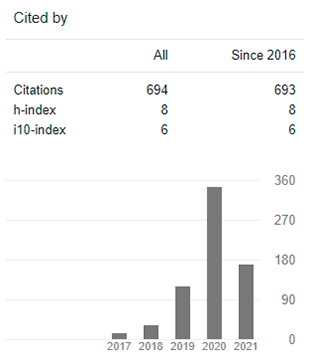Incidence of fluorocarbon compounds and nanoparticles in hydrophobic coatings
DOI:
https://doi.org/10.29394/Scientific.issn.2542-2987.2022.7.23.6.124-137Keywords:
covering, hydrophobicity, nanoparticles, fluorocarbonsAbstract
Hydrophobic coatings are widely used in the industry due to the protection barriers that extend their useful life. Water repellency is a protection alternative to outdoor conditions such as high humidity, determining its influence on the applied surface. The objective of this bibliographic review is to analyze the incidence of nanoparticles and fluorocarbon compounds depending on the contact angle and roughness through data collected from journals such as Elsevier, SciELO, and information from high-impact postgraduate works in academic Google. During the analysis process, the angle of contact with water was taken as referential data, with values greater than 90°, and roughness of 82 nm with nanoparticles and 0.43 nm in fluorocarbons. The hydrophobic nature of the compound allowed a decrease in roughness through the use of fluorocarbon compounds, otherwise it occurred with the incorporation of nanoparticles. However, the contact angle was similar between the two.
Downloads
References
Abidi, N., & Hequet, E. (2004a,b). Cotton fabric graft copolymerization using microwave plasma. I. Universal attenuated total reflectance FTIR study. Journal of Applied Polymer Science, 93(1), 145-154, e-ISSN: 1097-4628. Recovered from: https://doi.org/10.1002/app.20442
Chen, H., Fan, H., Su, N., Hong, R., & Lu, X. (2021a,b). Highly hydrophobic polyaniline nanoparticles for anti-corrosion epoxy coatings. Chemical Engineering Journal, 420(3), e-ISSN: 1385-8947. Recovered from: https://doi.org/10.1016/j.cej.2021.130540
Choudalakis, G., & Gotsis, A. (2009). Permeability of polymer/clay nanocomposites: A review. European Polymer Journal, 45(4), 967-984, e-ISSN: 0014-3057. Recovered from: https://doi.org/10.1016/j.eurpolymj.2009.01.027
Cubillo, J. (2019). Síntesis e industrialización de desencofrante hidrofóbico conteniendo sio2-ch3 para impermeabilizacion de estructuras civiles. Tesis. Ciudad Real, España: Universidad de Castilla - La Mancha. Recuperado de: https://ruidera.uclm.es/xmlui/handle/10578/23638
Jafari, R., & Farzaneh, M. (2012a,b). A simple method to create superhydrophobic aluminium surfaces. Materials Science Forum, 706-709, 2874-2879, e-ISSN: 1662-9752. Recovered from: https://doi.org/10.4028/www.scientific.net/MSF.706-709.2874
Jiménez, A. (2018). Microcontaminantes emergentes: PFOS y PFOA. Cuadernos del Tomas, 10, 215-228, e-ISSN: 1889-5328. Recuperado de: https://dialnet.unirioja.es/servlet/articulo?codigo=6573034
Montagut, A. (2017). Nuevos colorantes hidrofóbicos aplicados a la tinción de tejidos. Materiales modificados con nanopartículas de plata y antibióticos. Tesis. ISBN: 9788449076152. Bellaterra, España: Universidad Autónoma de Barcelona. Recuperado de: http://hdl.handle.net/10803/457905
Ogihara, H., Xie, J., Okagaki, J., & Saji, T. (2012a,b). Simple method for preparing superhydrophobic paper: Spray-deposited hydrophobic silica nanoparticle coatings exhibit high water-repellency and transparency. Langmuir, 28(10), 4605–4608, e-ISSN: 0743-7463. Recovered from: https://doi.org/10.1021/la204492q
Portillo, L. (2018). Hidrofobicidad de superficies poliméricas mediante inclusión de nanopartículas. Tesis. Hermosillo, México: Universidad de Sonora.
Sun, Y., Zhao, X., Liu, R., Chen, G., & Zhou, X. (2018a,b). Synthesis and characterization of fluorinated polyacrylate as water and oil repellent and soil release finishing agent for polyester fabric. Progress in Organic Coatings, 123(199), 306-313, e-ISSN: 0300-9440. Recovered from: https://doi.org/10.1016/j.porgcoat.2018.07.013
Urrejola, M., Soto, L., Zumarán, C., Peñaloza, J., Álvarez, B., Fuentevilla, I., & Haidar, Z. (2018). Sistemas de Nanopartículas Poliméricas II: Estructura, Métodos de Elaboración, Características, Propiedades, Biofuncionalización y Tecnologías de Auto-Ensamblaje Capa Por Capa (Layer-by-Layer Self-Assembly). International Journal of Morphology, 36(4), 1463-1471, e-ISSN: 0717-9502. Recuperado de: http://doi.org/10.4067/S0717-95022018000401463
Villanueva, M. (2009). Materiales nanocompuestos basados en polietileno y filosilicatos laminares obtenidos por mezclado en fundido. Estructura y propiedades. Tesis. ISBN: 9788469290477. Castellón, España: Universidad de Jaume Castellón. Recuperado de: http://hdl.handle.net/10803/10369
Wang, X., Hu, J., Li, Y., Zhang, J., & Ding, Y. (2015a,b). The Surface Properties and Corrosion Resistance of Fluorinated Polyurethane Coatings. Journal of Fluorine Chemistry, 176, 14-19, e-ISSN: 0022-1139. Recovered from: https://doi.org/10.1016/j.jfluchem.2015.04.002
Wu, Z., Tang, L., Dai, J., & Qu, J. (2019). Synthesis and Properties of Fluorinated Non-Isocyanate Polyurethanes Coatings with Good Hydrophobic and Oleophobic Properties. Journal of Coatings Technology and Research, 16(5), 1233-1241, e-ISSN: 1547-0091. Recovered from: https://doi.org/10.1007/s11998-019-00195-5
Downloads
Published
How to Cite
Issue
Section
License
Copyright (c) 2022 INDTEC, C.A.

This work is licensed under a Creative Commons Attribution-NonCommercial-ShareAlike 4.0 International License.
The content of the journals of this site, are under a Creative Commons Attribution-Noncommercial-Share Alike 4.0 International License.













